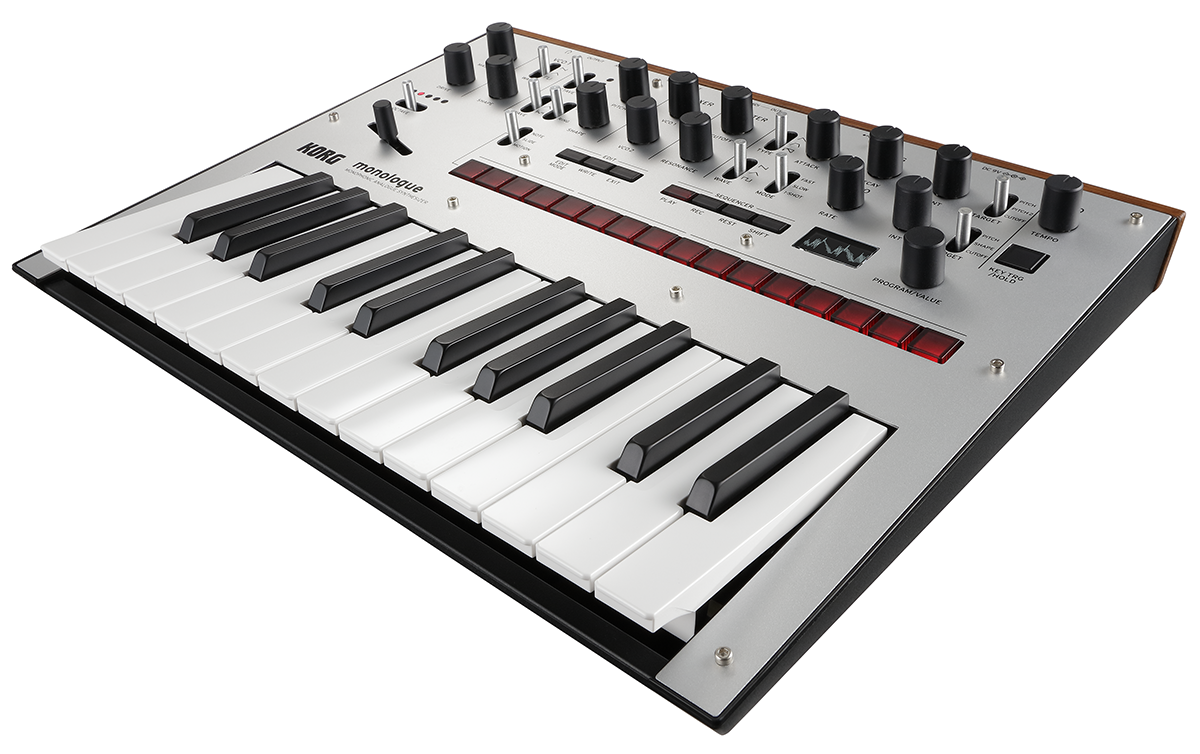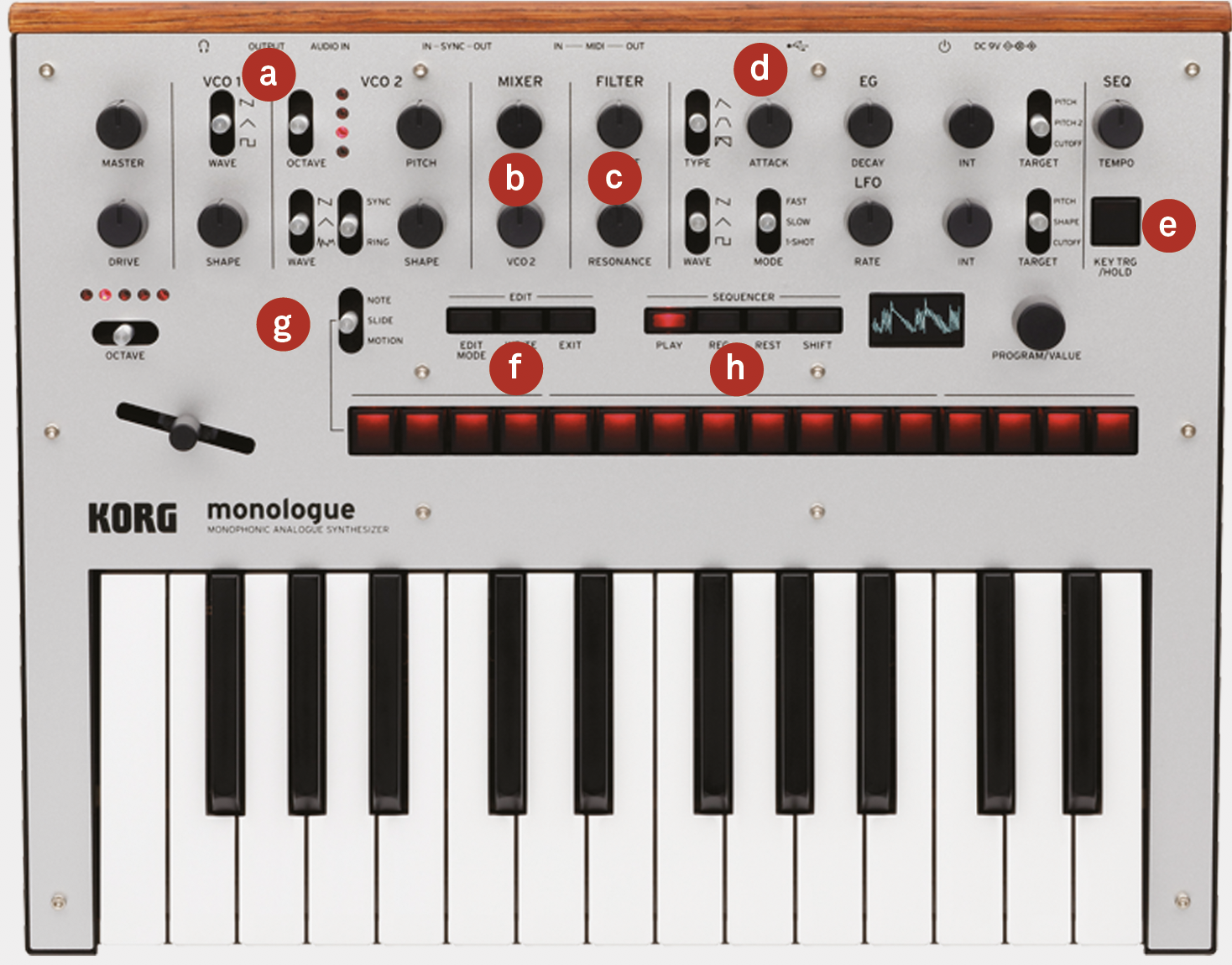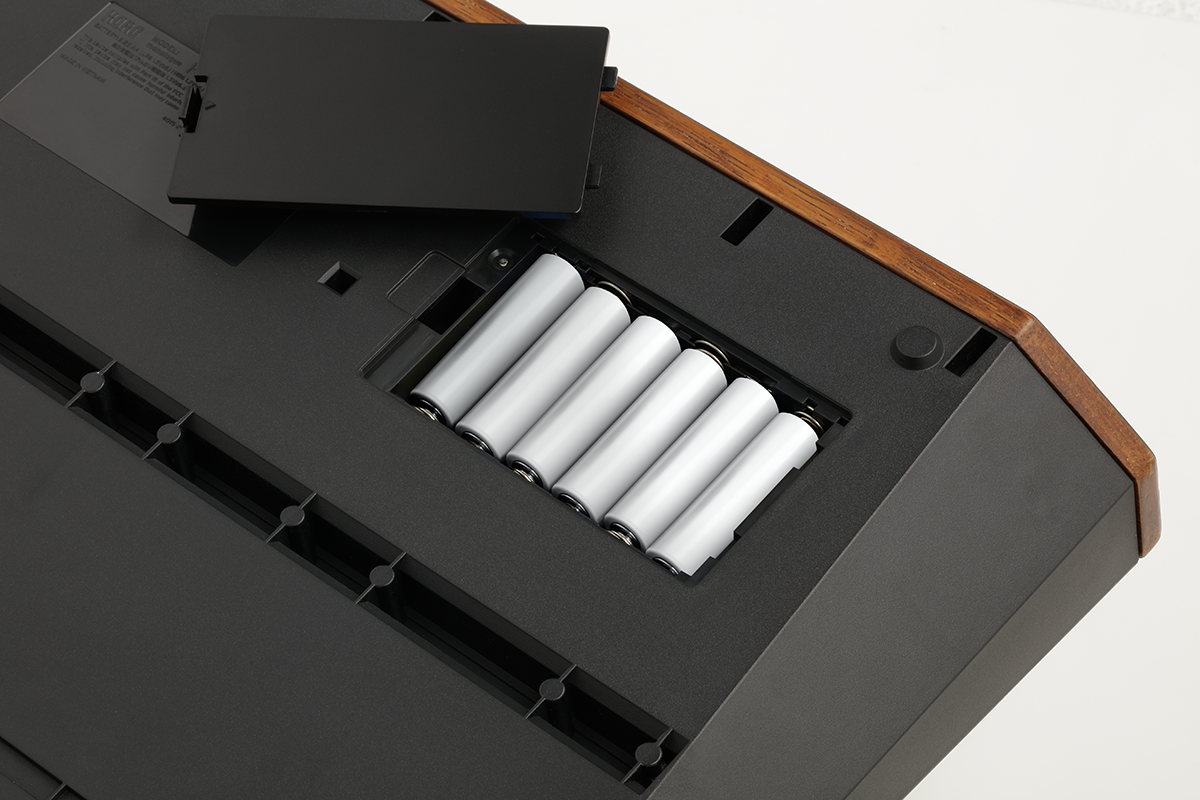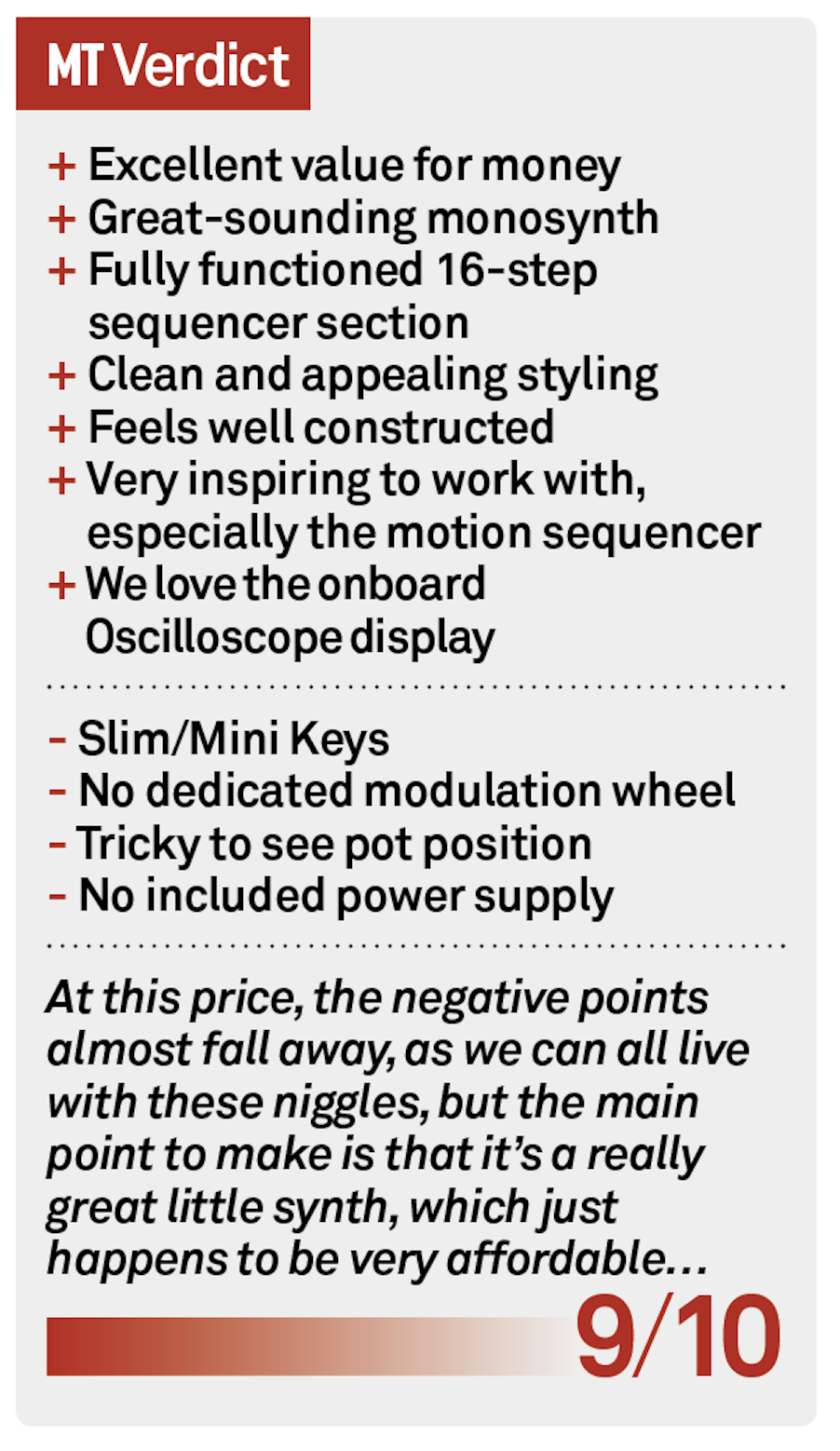Korg Monologue Review – A Life in Mono
Korg surprised us with the release of the polyphonic Minilogue, but now the Mini has a Mono brother, the Korg Monologue, which is even more pint-sized and colourful! Dave Gale powers one up to see how life in mono compares… Details Manufacturer Korg Price £299 Contact 01908 304600 Web www.korg.com/uk It only seems like a […]

Korg surprised us with the release of the polyphonic Minilogue, but now the Mini has a Mono brother, the Korg Monologue, which is even more pint-sized and colourful! Dave Gale powers one up to see how life in mono compares…


Details
Manufacturer Korg
Price £299
Contact 01908 304600
Web www.korg.com/uk
![]()
It only seems like a couple of months ago that I was sat at my desk, salivating over the wondrous Korg Minilogue – the surprise card from Korg that gave us a polysynth for under £500. I found myself being rather drawn in by it on a number of levels, not least of all because of its superb design and thunderous sonic capabilities.
Now I’m not superstitious, but as I typed away at my keyboard, the one annoying thing that kept happening was my spell checker would continually auto-correct ‘Minilogue’ to ‘Monologue’. It was almost as though somebody was trying to tell us something, or maybe it’s just that Monologue was almost a ‘given’ for the name of a monosynth from Korg, and that’s what they have now presented us with.
But unlike the Mini, the Korg Monologue is available in a choice of colours, namely black, blue, red, silver or gold. Is this a possible nod to another, now-legendary monosynth that was available in grey, blue and red?

The Design Factor
Now I don’t want to sound like I’m cutting and pasting my previous review, but let’s start with the design of the Korg Monologue. This thing is truly beautiful to look at – I’m fortunate enough to have the red version to review, which is not some garish shade, but a rather tasteful wine red, with white lettering that stands out and is clear to read and work with.
The pots remain black, but could still use a white line to indicate position, which I think would have set it off a treat. The keys remain ‘slim’ or ‘mini’ in size, and run the length of the unit – but, curiously, from the notes E to E.
This is not unheard of, but in a two-octave layout like this, I was surprised that it wasn’t from C to C. I am sure Korg will have its reasons, and they might well be to do with guitarists and bass players…
When I reviewed the Minilogue, I referred to the old Steve Jobs iMac adage of the back being prettier than the front of some other synths, and that applies here, yet again. It’s got striking looks in all directions, and turning it around reveals a lovely wood panel, which again has the sockets peeking through.

There are three 1/4-inch jack audio sockets, for headphones, mono audio output and mono audio input, and then we have the usual Korg suspects, in the shape of Sync In and Out
for Volcas, Eurorack and the like. For more conventional use, we have USB for MIDI, and a pair of MIDI sockets providing In and Out, and finally, a power switch with a 9v DC input.
I couldn’t help but notice on taking the unit out of the box, that there were six AA batteries, and if the Korg Monologue is turned upside down, a battery hatch is revealed. There is no included DC power supply, so you will doubtless want to get one if you’re likely to use it for any length of time – fancy sitting on a train playing a monosynth? (To be fair, the aforementioned multicoloured monosynth from Roland also had a battery capability, and I haven’t gone portable with that yet, either.)
Subtractive Architecture
Turning our attention to the front panel, the similarity with its bigger brother is pretty obvious, but there are subtle changes of downscaling, as one would expect, given the price point.
The architecture starts with two VCOs, both of which have waveshaping available, with VCO2 being open to both Sync and Ring Mod. VCO1 offers Saw, Triangle and Square, whereas VCO2 offers Saw, Triangle and White Noise, so if you’re looking to create a sub-oscillator-type timbre, you would need to reverse roles slightly, using the traditional Square of VCO1 in the lower octave.
No great shakes, but VCO1 does not have an octave/range control, so you would need to use the range of VCO2 to compensate.
The eagle-eyed will have noticed that there is an Audio Input available, which does not seem to have an onboard pot to tame volume, so any used device would need to have this available. The Audio In signal enters pre-filter, ready to add squelch.

Looking sharp from the rear as well as the front, the sockets are guarded by a wooden surround.
Talking of which, the VCOs have a two-pot mixer which feeds straight into the filter. Trying to recall exactly how the Minilogue sounded, it feels pretty similar, but it is fixed as a 2-pole/12db low-pass design, which will sweep and screech to your heart’s desire, with the back end of the signal chain open to an overdrive, which can really squelch, with a nod to the early 90s.
One of the most marked instances of downscale can be found in the envelope section. There’s a single Attack/Release-style envelope, which is predominantly assigned to amplitude/VCA duties; however, it does have a three-way switch to apply either a full sustain phase, or bypass it to a straight open gate, which is useful if you would like to assign the AR envelope to other areas. The primary envelope can also be assigned and attenuated in the direction of pitch, pitch of VCO2 only, or filter cutoff.
Lurking below this set of pots is the LFO section, which is actually slightly reminiscent of the LFO found on the Monotribe. This fully functioning LFO has both a slow and fast mode, the latter moving up into the audio spectrum; but, like the Monotribe, it has a handy ‘1-Shot’ mode, meaning that you can use it like an Attack/Release envelope, with a single strike, if placed in Sawtooth mode.
The Rate pot assists with the speed of fall, and given the Korg Monologue’s budget entry point, essentially offers what could be considered a simplistic second envelope. The LFO can also be used more conventionally, with selection to direct it towards pitch, filter and the rather wonderful waveshaping. The latter cannot be understated! Applying the LFO to waveshaping results in truly immense and beautiful sonic results, depending on context, and for me, this is definitely one of the highlights of using the Monologue.
Sequence your Circuits
Despite the mono-based architecture that we have here, the Monologue has a few tricks up its sleeve, which skirt around the lack of polyphony. The Sequencer section offers a full 16-step sequencer, which is nothing short of a breeze to use.
Some other companies could take note here, as I’ve encountered a couple of onboard sequencers recently that have left me scratching my head somewhat with anything beyond the basic step input. The key to this is a sensible layout of 16 dedicated sequencer buttons, each owning a step.

Is there a hint of Atari VCS* about the Monologue’s design?
Alongside this is a three-way toggle switch, which dictates the type of input, and as if this were not obvious enough, the sequencer mode momentarily flashes up on the display, which is the same beautifully crisp OLED display that is offered on the Minilogue. (The OLED also does the enchanting oscilloscope mode trick, which we all love so much!) Sequences can be entered in real time or step time, the latter bringing the display into play and very clearly presenting which step you happen to be involved with.
Recording in real time is nice and easy, too, but will require a small degree of menu surfing to find the Metronome function, which is located in one of the Global menus. Once activated, you can flick the mode to ‘note’ and punch record to play your notes in time to the pitched bleep of a metronome.
You can also record over the inputted notes with a second pass until you get what you want, or you can of course switch to step mode, and edit at your own pace. So far, so easy, but what’s this second switch position marked ‘Slide’? It’s that hark back to another favoured flavour from yesteryear, with the control of step by step portamento, from one step to another.
In this mode, it’s simply on or off, but lurking in the menu, you will find control of portamento speed and other functions, which can be found in the dedicated sequencer menu.
You can control step lengths and resolution, along with useful functions like gate and swing time, and unlike some menus, you’re guided by the lights of the 16-step sequencer, which flash to show selected pages and sub menus.
It’s worth mentioning that at the time of writing, I had nothing but a very brief Quick Start manual, yet I found the menu system exceptionally easy to get around and it was easy enough to locate the things I wanted, and indeed discover what capabilities were on offer – of which there are just enough to make you feel like you’re getting your money’s worth, but not so many that it becomes a chore.
However, the real coup is to come, in the shape of the ‘motion’ element of the sequencer, which accounts for the third position on the sequencer toggle switch. This, as they say, is where the magic happens. With a lovely nod towards the Volca range, the Korg Monologue is equipped with the ability to record any motion over the period of the 16 steps that you might choose to tweak once you activate record.
As if that weren’t enough, you can layer this up to four times. At first use, I chose to go with something obvious, like a filter sweep, which was easy enough to record: and, sure enough, recorded it was – with a basic overview of what I was recording in the display. And so the next tweaking of parameter happens, which is tracked onto a second line of the display.
It’s so easy to do and so effective, with everything shown in monochrome. As soon as you punch record, the motion detection begins, but in a very helpful way, record is punched out at the end of 16 steps, and note that it’s not at the end of the sequence, but 16 steps after you punched in… How useful and logical.
Taking a look at some of the factory presets, it’s easy to hear how far the sequencer can go, with some full-on sequences that almost make the Monologue sound polyphonic, and that’s largely down to a combination of both note sequencing and the motion-record capability.
Sequences do have a maximum count of 16 steps though, but they can be shortened to less, and I was very pleased to see the addition of a ‘rest’ button, the same functionality being available by just deactivating a step on the main sequencer buttons.
It’s a shame that there’s no arpeggiator, but it’s certainly possible to create very arpeggiator-like effects with the sequencer. Even better, there’s a hold and latch function that will allow the user to transpose sequences with a press of the keyboard. In many respects, I’d say that the sequencer is the dark star of this synth, in that it has much to offer but is only useful if it can be used elsewhere.

Battery-powered analogue is novel, but the power supply isn’t included.
That Sync’ing Feeling
So, with the sequencer in mind, let’s think about the sync’ing options.
We’ve already noted that there is a Volca-esque Sync Input and Output on the Monologue’s rear, and thankfully Korg has put in place some helpful sync-resolution elements to get around the fact the the original Volcas would sync to eighth note, rather than the more common 16th note.
The Korg Monologue will actually do both, and moreover, you can independently set the input and output, so you really do have complete control. This means that you could sync to an incoming signal from a Volca running on eighth-note sync, but fire off a 16th-note sync to something like a Eurorack.
Well done Korg, that’s what we all wanted, and you have clearly listened.
As well as the more analogue-style clocking options, the Global menu will allow clocking internally or externally, from either USB or MIDI connection, which will bring the sequencer under DAW control. Via the Program Edit page, it is also possible to clock the LFO, which is a very useful touch indeed.
Do I Really Need This?
Frankly, yes – if you’re into synths but you haven’t got around to buying any hardware yet, check this little guy out as an ideal place to begin. It sounds huge and is very versatile, and I like the idea that you can just sit down in front of it and have fun, without the need to turn anything else on. I sat in my lounge with the Korg Monologue on my lap and a pair of headphones, and before I knew it, two hours had gone by.
The fact that it can be very easily sync’d to other kit, and most importantly to a DAW via MIDI or USB, makes this an easy synth to both integrate and get your hands dirty with, in that immediate way that we all love with analogue synths. You can definitely have lots of fun with this…

Korg Monologue – Alternatives
The obvious contenders to the crown of cheap analogue mono synths come from two quarters – namely Novation and Arturia. The Novation Bass Station II is a highly acclaimed and very capable little analogue machine, which (despite the name) can do far more than just basses, although its architecture lends itself to this area, thanks to two oscillators and a sub.
Arturia, on the other hand, offers the MicroBrute, which is a smaller but no less capable machine – its single mutli-wave oscillator enables you to mix the saw, square and triangle characteristics, plus there’s an overtone Sub-Osc.
Coupled with the Steiner multimode filter and Brute Factor, Metalizer and Ultrasaw features – plus sequencer – and you have an extremely versatile machine that belies its single-oscillator architecture.
Korg Monologue Overview

a: VCOs – Two VCOs, with VCO2 offering all the flexibility, via the Oscillator Sync and Ring Mod.
b: Mixer – The basic Mixer section merges the two VCOs into a single signal stream, before moving to the filter.
c: LP Filter – A fully resonant low-pass VCF, offering a nice squelchy 2-pole/12db filter, perfect for classic monosynth duties.
d: Envelopes – The envelope section offers flexibility of routing, with an Attack/Decay style generator. The LFO will happily assist with similar duties, in ‘1-Shot’ mode.
e: Key Trigger – The Key Trigger button also offers ‘Hold’ latching, if pressed and held down. Perfect for getting sequences to play hands-free.
f: Edit Section – The Edit buttons allow for change of Global, Patch and Sequencer data, with the assistance of the 16-step buttons below, and the OLED display.
g: Sequencer Select – Sequencer selection of three parameters allows for very easy control of sequential operations. The step buttons display what is in operation, in cahoots with the display.
h: Sequencer Control – The Sequencer control buttons make light work of playing and recording on the fly – used to assist with step input, and especially rests.
Mono-mania
It’s fair to say that the Korg Monologue is a cracking little synth, with plenty of character, especially from the sequencer component, which I believe to be a really integral part of what this monosynth is about. There are some small gripes, in the shape of the ubiquitous smaller keys that seem to come with most products of this kind – and like the Minilogue, there is a singular pitch bend, which can be repurposed, according to what you’re trying to do.
But, overwhelmingly, this feels like a solidly built piece of kit which makes you smile when you use it. The form factor alone is worth high praise, but added to its simplicity of layout and architecture, it’s a thing of great joy and beauty.
The Korg Monologue ships with 80 factory sounds, leaving 20 blank for user storage, but any of the 100 patch locations can be overwritten to store user patches.
That’s pretty generous, but many of the factory patches are pretty damn good, as Korg has injected a superb element of coolness into the Korg Monologue, with some of the presets being programmed by Richard D James (Aphex Twin), which rather says to me that you probably won’t want to overwrite the Factory patches in a hurry! All is not lost, though, as Librarian software is due shortly, which will allow the user organise their patches accordingly.
Some of the factory patches are pretty complex, and I found myself looking at the Motion Sequencer data, to see how things had been programmed and learnt quite a bit from it, so more patch locations could be useful, but the Librarian software will at least remove some of the pressure.

One hitherto unmentioned element, which also had some input from the Aphex Twin, is that of microtuning, where microtonal atonality can be invoked across six octaves. Strangely, this is another one of those hark backs that seemed to be present on a lot of older digital synthesisers, but somehow disappeared and fell out of favour.
I guess how much of a use this could be is largely down to the kind of music you make, but it can be very useful for some electronic styles, but less useful to anyone wishing to use the Korg Monologue in more conventional placements. To help you along, there are both preset and user scales, some of which can be heard in the preset patches, where the micro-tonality becomes very obvious, but equally effective.
The lack of power supply is also another point to raise, but you can at least get going with the included batteries, and power supplies are pretty cheap, although I would always recommend buying a good quality PSU, rather than something cheap and cheerful, as a better power supply will hopefully not give too many of the issues that can be associated with extraneous noise and the like.
On pure character and price, this mono synth is a 10/10. But I have to drop it by a single point, purely to address the sum of minor gripes I’ve mentioned, but don’t let that put you off! It’s a cracking little mono monster and, really, it’d be a bargain at twice the price – and lest we forget, it’s absolutely an analogue monosynth

Korg Monologue – Key Features
● Single-voice monophonic analogue synthesiser
● Subtractive synthesis architecture
● Two-octave ‘slim’ keyboard with velocity
● Can be powered by batteries as well as DC power
● Multi-function 16-step sequencer
● Easily sync’d with other devices
● Available in five different colours
